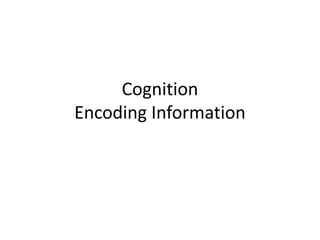
Cognition
- 2. Information Processing Sensory Memory Working Memory Long-term Memory In order to put information in our long-term memory, we must ENCODE it.
- 3. Ways to Encode: Mnemonic Devices Acronyms- Form of abbreviation Example: ROY G BIV for the colors of the rainbow Chain Mnemonics- connect items to be memorized in a jingle. Example: i before e, except after c Keyword method- Associating sounds/images with concepts. Example: student learning spanish remembers the word for cow, vaca, by imagining a cow on vacation Loci Method- Associating items with locations in familiar settings. Example: to remember grocery list, picture items sitting around the house (milk in the fridge, ect.)
- 4. Ways to Encode: Mnemonic Devices Continued… Peg-type Method- Associate things you already know to the new information. Example: Connecting items on your grocery list to words that rhyme with numbers. 1-bun, your first item is blueberries, so you associate that with bun (buns are raining down on blue bears) and then rhyme that with the number one. Verbal Mediation-Using a word or phrase to connect two pieces of information. Example: the principal is my pal-use to remember the spelling of the end of that form of the word
- 5. Ways to Encode: Visual Imagery Involves constructing mental pictures
- 6. Dividing Broad Concepts into narrower concepts and facts. Ways to Encode: Hierarchies
- 7. Encoding for Problem Solving Algorithm- a prescribed sequence of steps for achieving a goal. Example: a2 + b2 = c2 Heuristic- general problem-solving strategy that might lead to a right answer or to a solution that usually is reasonably close to the best possible answer. Example: PEMDAS– order of opperations
- 8. Sources Facts/Information borrowed from: EdPsych Modules by Lisa Bohlin, Cheryl CiseroDurwin, and Marla Reese-Weber, Modules 11, 13-14 Additional Information on Peg-Type Method: http://www.memory-improvement-tips.com/remembering-lists.html
- 9. Sensory Memory Can hold an unlimited amount of information for a very short time
- 10. What do we tend to pay attention to? Size Intensity Novelty Incongruity Emotion Personal Significance What do students tend to pay attention to?
- 12. Story Time
- 13. Working Memory Holds information about 30 seconds Rehearsal Why is it hard for slow readers to understand what they are reading?
- 14. Miller’s Magic Seven 9 5 2 8 4 9 0 3 6 5 8 3 5 7 1 2 1 9 3 1 5 0 8 1 1 2 3 4 5 6 7 8 9 1 0 1
- 15. Maintenance and Elaborative Rehearsal
- 17. Serial-Position Effect We are more likely to remember things at the first and last. Acrostic—Every Good Boy Does Fine
- 18. Long Term Memory Retains unlimited amounts of memory for an indefinite amount of time.
- 19. Types of Knowledge Explicit Implicit (Tacit) Why is Michel Jordan a terrible basketball coach?
- 21. What
- 22. How
- 24. Recognition Knife Hole punch Pill bottle Tape Big Ben Mount Rushmore New Moon Movie Notebook Address Book Phonebook Microphone Staples The Book Thief Binder BYU Arts brochure Spoon Lincoln Memorial Jefferson Monument Roster Headphones Happy Birthday Sign Post-it notes Staple Remover Staples Alarm clock Bowl Washington Monument
- 25. Transfer Automaticity is important for Low-road Mindful abstraction is for high-road
- 26. Obstacles to Transfer Functional Fixedness Response (Mental) Set Belief Perseverance
- 27. Problem based learning (PBL), and functional fixedness ill or well defined problems?
- 28. How should you study? Mass practice vs. Distributed practice Semantics http://www.brainpickings.org/wp-content/uploads/2009/11/forgetting_curve.jpg
- 29. How should we teach? Anyone…